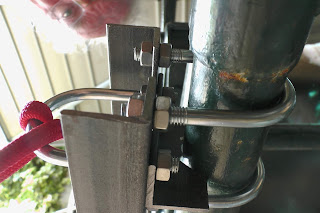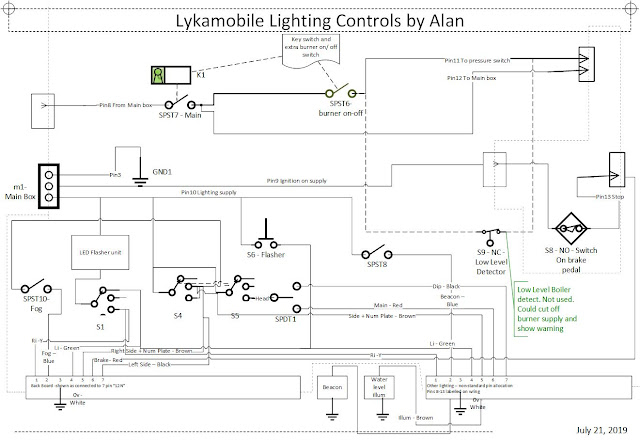I have been thinking about this topic and tried out some ideas:
The Lykamobile series 2 (“Lyka2”) provides for the driver to
monitor boiler water levels using the sight glass, in common with established practice
for steam engines, steam cars and locomotives.
Modern static steam generating facilities are required to use automatic
means for monitoring and responding to boiler water levels.
It is a sensible argument that mobile steam
generation should do the same (but don’t push for this as a new regulation to haunt
existing steam locomotive users).
As a desirable objective, the various means of detecting
boiler water levels should be considered:
- - Conductive detection:
- - Physical level detection;
- - Capacitive detection;
- - Optical detection.
Conclusions on the above methods in the context of Lykamobile
construction have been subject to my preliminary observations.
1.
Conductive
The original Lykamobile used a set of conductive probes in a
separate vertical copper tube, in the position normally used for the optical sight
tube, to determine boiler water levels at pre-set points.
The plumbing is an extra for Lyka2.
The electronics is not complex, but requires
some expertise for design and assembly.
Some users have reported using spark plugs as suitable detectors, as
they isolate the detection probe and provide for a seal against pressure.
I had some left over from the car I maintained
50 years ago!
At room temperature and
pressure, their resistance measured >20Mohms when dry and ~400kohms when immersed
in water. A simple detection circuit could be arranged to drive the burner relay
and a warning light.
I have no
information on the electrical characteristics of water and steam at 200+ psi,
so cannot assess if my assumptions would be valid.
2.
Physical
a.
Pressure
Some modern systems use a differential pressure monitor to
measure water height – I have not investigated this option – it looks a bit complicated
for an ”Add-on”
b.
Flotation
It should be possible to attach a magnet to a float in the
sight glass (or a copper tube in parallel) , and then use a reed switch to detect
the position of the magnet -
no extra plumbing
is needed for the sight glass.
I am
not sure about the material for the float.
Many plastics sink; others melt at the temperature reached by water
boiling at 200+ psi.
When I put expanded
polystyrene in my cooker at 220deg C, it started to melt and shrink, but
remained buoyant.
Polypropylene (the lid
on my Swarfega container) just floats, and seems to have a tolerable melting
point.
I would worry about putting
plastics in the sight tube;
we could end up with gloop to block the
waterways, or re-inventing the 1960s-style lava-lamp but for high pressure boiling
water.
Perhaps the plastic could be
contained in a metal cap from a water bottle (e.g. tonic – let’s all have a gin
and tonic for experimental purposes).
This looks like a possibility.
3.
Capacitive
Some modern systems rely on the capacitive properties of
water. I have not investigated. It seems to involve the use of an a.c. detector
voltage.
4.
Optical.
Both refractive index and opacity vary between water and
steam.
These could be used to trigger a
response when a certain water level is reached in the sight tube.
I have found that a glass container will not trigger a
response from my battery operated soap dispenser, but when filled with water,
the same glass container will set off the trigger.
I can only conclude that the detector and electronics respond to water
as if it were opaque – quite possible if the source were an infra-red LED.
To buy and re-work such a dispenser (from
Reckitt) might be a solution.
There would
be no need to re-work the Lyka2 pressure pipe-work.
If a black and white pattern is placed behind a half-full
bottle, then the refractive index of water causes the pattern to move (as in a
magnifying glass); careful alignment of an optical detector might be used to measure
water level.



















